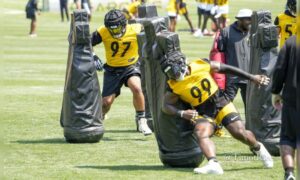By Matthew Marczi
When Pittsburgh Steelers linebackers coach Keith Butler spoke earlier this offseason of a rotation at the outside linebacker position during this season, I was skeptical, recalling past comments from other position coaches of rotation plans that never came to fruition. See, for example, the limited playing time of Cameron Heyward from a season ago, barring games in which injuries occurred.
However, as was evident by any observer with even the slightest interest in the matter, it was demonstrable that the Steelers were regularly rotating their linebackers during the team’s third preseason game against the Kansas City Chiefs.
Jason Worilds started the game on the right side, where he figures to be when the regular season begins, with LaMarr Woodley in his traditional left outside linebacker spot. However, on the second drive of the game, the Steelers inserted their first round draft pick, Jarvis Jones, into the lineup at the right outside linebacker spot, with Worilds taking a drive off on the sidelines.
Some were quick to read into that that Jones was gaining ground over Worilds to start at outside linebacker in the season opener, but that does not appear to be the case, considering how the rest of the game went. More likely, it is actually the versatility of Worilds that will afford Jones a greater playing time this year until he emerges as a starter.
On the third drive, Jones stayed in the game, but Worilds moved over to Woodley’s spot at left outside linebacker. While Worilds has been the primary reserve at right outside linebacker since he was drafted, in actuality, he has received most of his playing time at left outside linebacker, with Woodley battling injuries over the past two seasons.
Because Worilds has the ability to play at a competent level on either side of the defense, it affords the Steelers the luxury of keeping Jones over at the right side, where he is most comfortable, at least until he has a better grasp on the defense. That allows them to play any combination of the three at any given time—or even all three in certain blitz packages, which I firmly believe is inevitable given the number of blitzes that Jones executed from an inside position.
Jarvis Jones did a better job of holding the point in the run game, as evident in the early short-yardage standoff on third and fourth down that took place on his first series of the game. His demonstrating the potential aptitude for playing the run will only help to instill confidence in the coaches that they can keep Jones in the game and not worry about him blowing his assignment.
With a greater number of snaps under his belt, he appears more comfortable and decisive in his movements, in addition, and as a consequence, he looked to be playing with greater quickness and strength.
The rotation remained consistent through the first drive of the second half, after which the second-team took over: Woodley-Worilds; Woodley-Jones; Worilds-Jones. After that, Jones continued to play at right outside linebacker—opposite Chris Carter—until he exited the game after being injured on an interception return.
Regardless of whether or not Jarvis Jones becomes a starter at some point this season, the Steelers will likely continue to use a rotation at outside linebacker throughout the year. With Jones’ inexperience and Woodley’s recent string of injuries, having a three-man rotation should be the best option for the linebackers and for the team, keeping their pass rushers fresh and on-point. Would they have done that with a healthy Woodley and James Harrison a few years ago? Likely not, considering the two hardly came off the field. However, they also would not have drafted Jarvis Jones in the first round, either.







